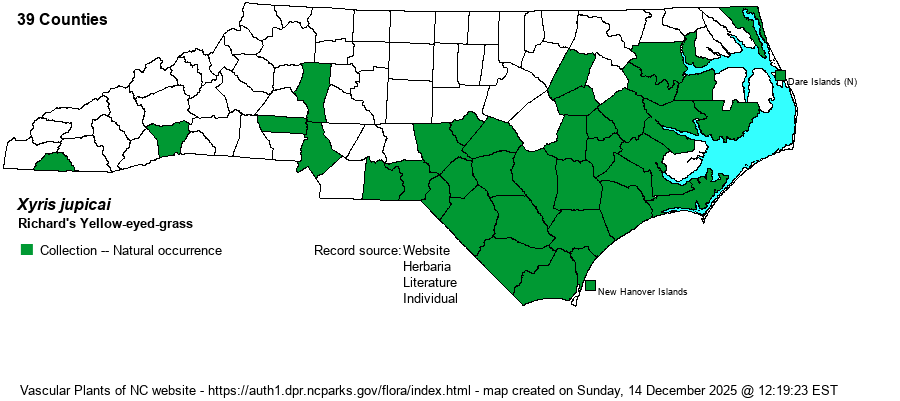| Author | L.C. Richard | |
| Distribution | Coastal Plain and Sandhills; a few widely scattered records in the Piedmont and southern Mountains.
NJ to southern FL, west to TX, OK, AR, and TN. Mex., C.A., W.I., S.A. | |
| Abundance | Frequent to locally common in most of the Coastal Plain, but not numerous in the northern portion. Very rare in the Piedmont and southern Mountains. The website editors suggest that the existing State Rank of S3S4 is too conservative; S4S5 is more realistic. | |
| Habitat | This species is the one most likely to be found in a disturbed habitat. Moist to seasonally inundated impoundment shores, ponds, drained beaver ponds, roadside ditches and pools, cypress-gum depressions, open seepage slopes, montane seepage bogs, roadside ditches, scrapes, forest clearings. | |
| Phenology | Flowering and fruiting July-September. | |
| Identification | Richard's Yellow-eyed-grass must be identified with care, as it has no outstanding characters of its own. It is a medium-sized species, with scapes 1-2 feet tall and leaves nearly that long and 5-10 mm wide. Lateral sepal keels are irregularly cut and shorter than the scales. Leaves lack pink or maroon tones basally. | |
| Taxonomic Comments | There appears to be two entities within this one species name, one much smaller and slenderer than the other. However, until a paper is published, we prefer to recognize only one.
Members of Xyris are easy to identify to genus, but can be a challenge to identify species. Careful observation of a few features with a hand-lens is usually sufficient. Close attention must be paid to the flowering head, which is composed of overlapping brown scales. Immediately behind each scale are two brown "lateral sepals"; the margins of these may be feathery or irregularly lacerate (cut into narrow segments) or finely cut into short, comb-like prickles. Lateral sepals may be hidden or a bit longer than each scale. The flowers themselves are usually of little diagnostic value, other than time of flowering -- morning vs. afternoon. Seed size and ornamentation can also be useful characters, but require a dissecting scope to see well. Note also whether leaves and scapes (stems) are twisted and the color of the basal portion. All species have 2-ranked leaves, but in some species the leaves are arranged in a broad, fan-like shape. Finally, note the leaf and stem surface texture -- whether smooth of with little pale bumps. See Godfrey & Wooten (1979) for detailed descriptions and drawings. | |
| Other Common Name(s) | Named for Louis Claude Marie Richard (1754-1821), French botanist who collected plants in the West Indies in the 1780s. Thus, the common name is pronounced "ri-SHARD" rather than "RICH-ard". | |
| State Rank | S3S4 [S4S5] | |
| Global Rank | G5 | |
| State Status | | |
| US Status | | |
| USACE-agcp | OBL link |
| USACE-emp | OBL link |

